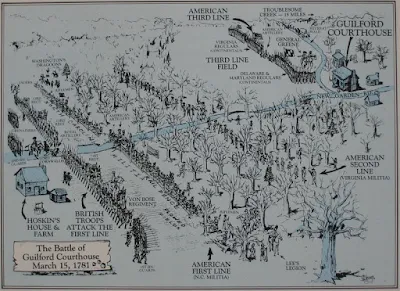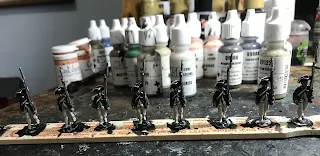 |
| Charles Lefferts illustration. |
 |
| Company of Military Historian plate. |
What was the uniform worn by the Delaware Battalion in 1776? Traditionally, our view of it is based on the illustration by Charles Lefferts in his book "Uniforms of the American Revolution." A regimental coat faced and lined red, white waistcoat and buck skin breeches with shoes and gaiters. Lastly, a leather cap with the seal of the Colony of Delaware and the words "Delaware Regiment" crown the uniform. Later, the Company of Military Historians issued a uniform plate based on his work. This has been our traditional view and one that is time honoured. But is it correct? What documentation do we have?
On 13 January 1776 the Delaware Committee of Safety suggested recruits "...be allowed instead of a bounty, a felt hat, a pair of yarn stockings and a pair of shoes." Much later there was another suggestion by the same body that recruits receive " 1 regimental coat, 1 jacket without sleeves, 1pair of buck skin breeches or 2 pair woolen or linen ditto, 1 hat or leather cap, 2 shirts, 1 hunting shirt, 2 pair overalls, 2 pair stockings, 2 pairs shoes and 1 blanket." There is no indication of these were followed or actually issued to the men.
What was issued to the battalion? We know Colonel John Haslet, the first commander of the battalion recorded in his account book that the government be charged for "688 hats for soldiers as bounty at 8/274.4". In addition the colors and drums of the battalion were made by Plunket and Fleeson of Philadelphia. They also made the drums and colors for Captain Thomas Rodney's Dover Light Infantry company in 1775. While no illustrations of the colors or drums are in existence we know the flag carried by the Dover Light Infantry was green with a white field and red strips.
There was one deserter from the regiment in 1776 that gave us a written description of the uniform. Corporal John Eashom deserted in May 1776. He is described as wearing a "blue regimental coat turned up red, with yellow buttons and a white broadcloth jacket and breeches." Another deserter in early 1777 appears to be wearing a similar uniform. A deserter from Captain Samuel Smith's company on 18 February 1777 is described as wearing the old uniform "...an old felt hat, deep blue coat with metal buttons marked "DB" and a old pair of buck skin breeches. ". Finaly, a Hessian officer described the regiment as wearing a "blue and red coat."
An unusual but interesting suggestion for the uniform comes from the Delaware currency . A four pence note, printed in May 1776 had a soldier wearing a regimental coat, breeches and spatterdashes. The waistcoat is cut straight across with a cloth belt. The headgear is a round felt hat cocked up on the left side. Could this be a illustration of a soldier of the Delaware Battalion?
Based on this information we can come up with a good view of how the battalion looked in 1776. They wore a blue regimental coat lined and faced red. A white waistcoat with either buck skin breeches or wool or linen breeches or overalls. But what of the head gear?
 |
| Reenactor wearing reconstruction of possible cap. |
Documentation for the cap shown in so many illustrations is scarce. The modern recreated unit wears this cap. Modern interpretation of the cap seem to come from Charles Lefferts illustrations. But these were published after Lefferts death so we do not know where he got his information about the cap. There is a cap in existence that was offered to the Delaware State Museum. This cap was examined by State authorities. They found a name of a late 19th/ early 20th century Philadelphia manufacturer imprinted inside the cap. The cap was made of "Fabricoid" a synthetic fabric invented in the 20th century that resembles leather. Since it was obviously a modern reconstruction it was rejected from the Museum.
Various individuals writing about the cap place great store in the painted seal on the front of the cap, both individuals for and against the cap. I do not understand why this is important. Both sides cited positives and negatives about what is depicted. To my mind the most curious part of the seal is the name Delaware Regiment on it. All period writing use the name Delaware Battalion. The buttons of the battalion are marked "DB" in 1776. Later, the new unit in 1777 was called the Delaware Regiment and buttons were changed to "DR".
 |
| Modern painting showing the battalion in felt, round hats and color based on Dover Light Infantry flag |
I think the evidence for the cap is very thin. The suggestion of a hat or cap for recruits leaves the door open for the possibility there might have been caps issued, possibly to a light infantry company. But I could not see in the organization of the battalion if a light company was authorized. On the other hand felt hats are most definitely mentioned as worn and we know they were purchased for the battalion. The money printed for the colony that show a soldier in a round hat is interesting. These were very common during the period. The later 1777 regiment wore hats with yellow edging rather then the usual white. I have found nothing mentioning this in 1776.
For my collection I will field the Delaware Battalion in felt hats for 1776, either cocked or round depending on the figure. I feel based on the available evidence this is the most correct interpretation. But I will not fault any gamer who fields them in caps. In this hobby one looks at the evidence and draw your own conclusions
For additional information and reading I highly recommend the following books and articles.
Philip Katcher. Uniforms of the Continental Army. December 1981.
Donald Londahl-Smith. "Notes Concerning the Uniform of the Delaware Battalion in 1776"
Company of Military Historians Spring 1967
Mark Zlatich. General Washington 's Army (1): 1775 - 78































